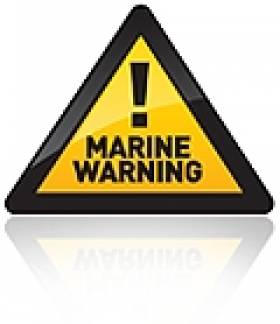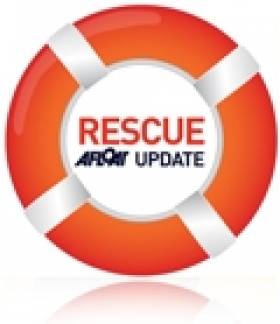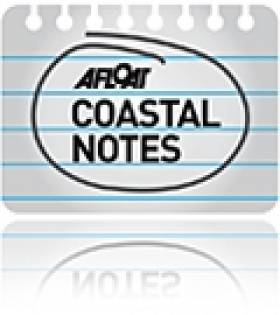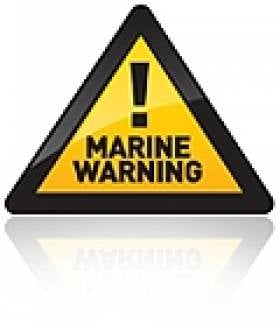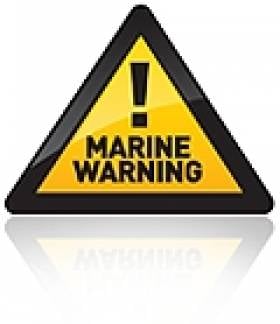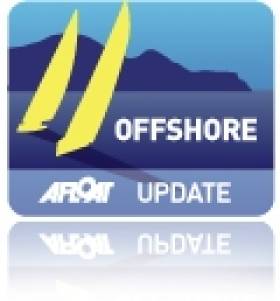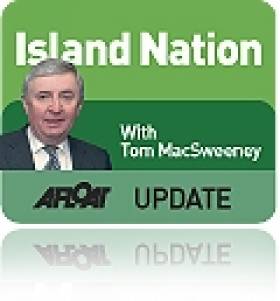Displaying items by tag: Safety
German Highest Honour for Irish Lifesaver
An International Lifesaving Conference for European Lifesaving Federations from 22 countries throughout Europe was held in Dublin last weekend. Many issues concerning water safety and rescue were discussed, with particular emphasis on standardisation within Europe with regard to beach safety, swimming pool safety and rescue techniques. At the closing ceremony the President of International Life Saving (Europe), Dr. Klaus Wilkens thanked Irish Water Safety for hosting the event, which was last held in Ireland in 2004. He spoke warmly concerning the facilities available in Ireland for the holding of such conferences and the renowned welcome of the Irish in quoting "a hundred thousand welcomes" for which the Irish are world renowned.
Dr. Wilkens, who is also the President of the DLRG (German Lifesaving Organisation) which ranks as one of the largest lifesaving organisations in the world, took the opportunity to present that Organisation's highest honour to Mr. Frank Nolan, Chairman of Irish Water Safety, in recognition of his dedication and loyalty to lifesaving at home and worldwide. In presenting the Gold medal, Dr. Wilkens explained that Irish Water Safety and the German Lifesaving Federation had worked closely over many years since 1971 to promote safety for all to enjoy the great benefits that the aquatic environment has to offer. As a mark of this fact the Presidium of the DLRG wished to honour Frank Nolan.
Frank Nolan who is a retired member of the Garda Siochana and having served in the Waterford Kilkenny Division has given a lifetime commitment to the promotion of water safety and rescue in Ireland and abroad. He is an expert in water safety matters, sea rescue and cliff rescue and is the present Chairman of Irish Water Safety, which comes under the auspices of the Department of the Environment. He serves on many national and international committees with regard to water safety and his opinion is valued.
Report Into Loss of Janireh Crewman Now Online
The full report of the investigation into the loss of a crewman from the fishing vessel Janireh earlier this year is now available online.
Egyptian national Nadi Sehsaah died after falling overboard from the trawler some 20 nautical miles south west of Mizen Head. It is believed he was not wearing a flotation device at the time of the accident.
The Marine Casualty Investigation Board (MCIB) has said there is an onus on the fishing industry to improve safety standards across the board, according to the Irish Examiner - which has more on the story HERE.
The MCIB report is available to download HERE.
Firm Offers Security for Wexford Lifebuoys
A security firm based in Wexford town has offered electronic protection and 24-hour monitoring to Wexford County Council in a bid to secure funding for lifebuoys on Wexford Bridge.
According to the Wexford People, the move comes after a spate of accidents involving people falling from the bridge, which is one of the longest in Ireland. The original lifebuoys were removed several years ago due to vandalism.
SAR Ireland has more on the story HERE.
Safety Notice Issued after Winch Accident
The safety message reads: "Safety is of paramount importance to Lewmar and, in advance of the outcome of the investigation and as part of our ongoing commitment to operational safety, we would like to remind owners of Lewmar manual and electrically-operated winches of the following key points from the Lewmar Electric 40-77 & Hydraulic 46-111 Winches Manual, Sections 2.1 and 6.1: All safety notices are available in the relevant Lewmar Technical Manuals on Lewmar.com. Click on Support, then Product Literature, and filter by product. If you have any questions or need any further information about the safe operation of a Lewmar product, please email [email protected].
Flood Evacuation Exercise in Fingal This Weekend
Members of the public are invited to attend a major flood evacuation training exercise this Saturday at Broadmeadow Esturary in Swords, Co Dublin.
Rescue and boat rescue crews from the Irish Coast Guard are sceduled to join teams from the Dublin Fire Brigade, the Civil Defence Fire Service and Gardaí in the exercise, which will simulate the rescue of a group of people stranded after a flash flood.
The crews will test water rescue and river search procedures, with an emphasis on general water safety and providing assistance to other search and rescue agencies.
The excercise will begin at 11am on Saturday 16 April and will last for one hour. Members of the public are welcome to observe must must obey any instructions and must not interefere with the exercise.
For more information contact Bill Powderly, assistant chief Civil Defence officer with responsibility for the Fingal Area, at [email protected] or 086 380 5197.
New Oil & Gas Safety Framework to 'Learn Lessons of Gulf'
Ireland's new safety framework for oil and gas extraction and production will be informed by lessons learned after the Gulf of Mexico oil spill, The Irish Times reports.
A report published last week by the Commission for Energy Regulation (CER) outlined that the framework will be developed over the next two years, will be independent of the Department of Energy, and will be implemented in an "open and transparent manner".
The report also highlighted overlaps - and gaps - between state agencies involved in monitoring or working with the oil and gas industry.
One step towards resolving this is the CER's new remit for public safety - which applies to controversial project such as the Corrib gas field.
The Irish Times has more on the story HERE.
Weekend 'Super Moon' Increases Risk of Strandings
The moon will be at its closest to earth since 1993 on Saturday March 19th.
This "Lunar Perigee", or 'Super Moon' as some astrologers refer to it as, is the opposite of the "Lunar Apogee", when the Moon is furthest from Earth. Generally, the Moon looks about 12-14% larger at its perigee compared to its apogee.
This has the effect of causing very high and low tides, or increasing the range of the tide. This will expose large areas of beach and rocks which we normally don't see. Many people enjoy walking on our beaches and exploring these new areas of beach and in particular people enjoy picking shellfish to eat which become exposed during these very low tides.
The risk to the public will be of becoming stranded as the tide advances back in which can leave people in a position where they are cut off from the shore. Members of the public are cautioned to be aware of this risk and carry your mobile phone. Should you get in to trouble then call 112 or 999 and ask for Marine Rescue, giving your exact location and in particular if you are near to any conspicuous landmarks nearby to assist the Rescue Services in locating your whereabouts.
All seafarers, surfers, swimmers and divers should be aware of the increased tidal streams that will be running around our coast over the weekend; people could find themselves in peril as a result of these strong and fast tidal conditions which have not been experienced for some time now.
Coastal Flooding Risk Warns Irish Water Safety
Flood conditions expose the public to hazards they need to be aware of. Fast moving water can exert pressure of up to four times its speed against the legs of someone attempting to cross it. Because water displaces bodyweight, the deeper a person becomes immersed the less the person weighs so the more difficult it is to remain upright. Never put ones feet down if swept away in floodwater, because foot and body entrapments and pinning are the leading cause of accidental death in rivers and fast flowing water.
Motorists need to be vigilant to avoid flooded areas on roads but particularly near rivers; with poor light and short days it is not possible to determine the depth of floods easily. Swift water will carry cars and other vehicles away and there have been very tragic drownings in the past as a result.
Children are naturally curious about water, therefore parents should caution them that floodwater hides the true depth and that manhole covers may be open and that small streams when swollen are very fast and deeper than normal.
What should I do when I hear a Flood Warning?
· Listen to the national and local radio for met eireann updates and AA Road watch updates
· Check on neighbours particularly if they are elderly, infirmed or families with young children
· Move your vehicles to higher ground
· Move animal stock to higher ground
· Check your small craft to ensure they are well secured or moored
· Make sure you have warm clothes, food, drink, a torch and radio.
· Block doorways and airbricks with sandbags or plastic bags filled with earth. Floodgate products will also work effectively.
· Switch off gas and electricity supplies if flooding is imminent.
· Check the time of High Water in the Newspaper or on http://easytide.ukho.gov.uk/EASYTIDE/EasyTide/SelectPort.aspx
· Check out www.flooding.ie for more detail on General flooding
Personal Safety
· Avoid flood waters at all times
· carry a mobile phone at all times in case you need to call for help - call 112 in emergency
· Wear suitable protective clothing & a lifejacket on or around water
· Do not enter fast flowing water.
· Never put your feet down if swept away by fast flowing waters
· Flooding on roads will be deeper at dips and around bridges.
· Stay away from sea and flood defences.
· when walking or driving, be aware of manhole covers and gratings that may have been moved due to the heavy flow of water.
· Take care when using electric appliances in damp or flood conditions.
· Remember that during the hours of darkness the dangers are multiplied.
After the flood
· Avoid eating food that has been in contact with flood water.
· Run water for a few minutes and wash your taps.
· Check gas and electricity supply.
· Leave wet electrical equipment alone to dry and have it checked prior to use.
· Ventilate your property well.
· Check on elderly neighbors.
Sailing Firm Fined Over Safety Breaches
The director of a sailing firm who sent students across the Atlantic on an unsafe yacht with an unqualified captain has been fined and ordered to pay costs by a British court.
According to the Isle of Wight County Press, a Southampton Crown Court judge told George Haworth of In2Sail Ltd that if he does not pay up he would be jailed for six months.
The court heard that Haworth sold voyages to students for more than £8,000 per head, but did not have boats equipped with the minimum lifesaving gear required.
It also heard that students had been sent on a trip to St Lucia with a skipper not fully qualified for a yacht and with only basic equipment to operate within 60 miles of a safe haven.
Defending barrister Charles Crinion said his client’s "good reputation had been irrevocably damaged" and has cost him his business, with a personal loss of £45,000.
Haworth admitted two counts of failing to take reasonable steps to ensure the yacht was operated safely.
The Isle of Wight County Press has more on the story HERE.
Lifejackets and Many Kinds of Racing
The wearing of jackets is not compulsory, but a decision for the individual sailor, though Skipper can insist that crews use them while racing.
In the United States a debate is underway as to whether the wearing of jackets at all times on racing boats should be made compulsory by law. Regulations here require that everyone on board any boat of seven metres or less, approximately 22 feet, must wear lifejackets. They must be carried aboard for everyone on any vessel regardless of size. Every child less than 16 years of age must wear a lifejacket or personal floatation device at all times on deck while the craft is underway.
As owners prepare boats for racing this season, these regulations should be kept in mind. Enforcing the law, or even effectively checking its application remains patchy. Introducing laws is easier than implementing them, particularly in a yacht racing situation. Sailing clubs have their own enforcement arrangements and insist on buoyancy aids for dinghy racing.
Safety on the water is an issue for each individual, but skippers/owners would be well advised to protect themselves in this litigious nation by insisting on the wearing of lifejackets by crew members during racing. Accidents will happen. Preparation is best.
The national sailing association, the ISA, is to nominate teams for this year's Nations Cup match racing. The finals will be held at the USA Sailing Centre in Wisconsin from September 13-18.
The Irish Sailing Association this week sought expressions of interest from skippers who would like to represent Ireland, in the first instance at the European Regional Finals in Gydnia, Poland, from July 19-23.
Ireland is drawn in Europe Group II in the open and women's classes. Expressions of interest are needed to the ISA by next Tuesday, February 8. Selection will be based on performance in the ISA Match Race Championships last year and ISAF ranking positions.
2-handed class" racing in this year's Dun Laoghaire Week in early July. A number of skippers have already expressed interest and there may be UK boats. He wants to know if any South Coast sailors are interested. Contact Olivier who is Sailing Manager at the National Yacht Club in Dun Laoghaire, phones 012801198 or 2805725 or by Email to Olivier at: [email protected]
Vinnie O'Shea of the RCYC has been elected Commodore of the South Coast Offshore Racing Association (SCORA). Jackie Kenefick of Schull Harbour SC is Executive Officer and Michael Murphy of both the Schull and Crosshaven clubs remains as Treasurer and PRO. The Association is to discuss class bands and handicapping.
This article is reprinted by permission of the EVENING ECHO newspaper, Cork, where Tom MacSweeney writes maritime columns twice weekly. Evening Echo website: www.eecho.ie
More on lifejackets
http://www.afloat.ie/safety/lifeboats/item/13619-majority-of-lifejackets-fail-lifeboat-test/






























